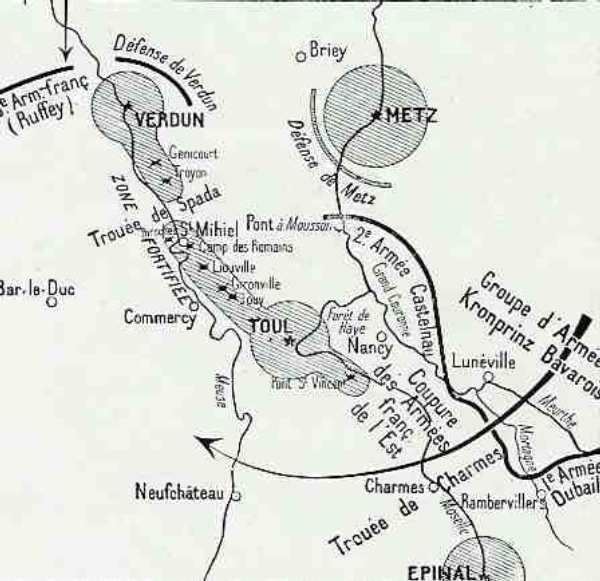Dates 24 Aug 1914 – 26 Aug 1914 | Result French victory | |
 | ||
Similar World War I, Battle of Grand Couronné, Battle of Lorraine, Battle of the Frontiers, Battle of Mulhouse | ||
The Battle of the Trouée de Charmes (French: Bataille de la trouée de Charmes) or Battle of the Mortagne was a battle between 24 and 26 August 1914 after the Battle of the Frontiers, at the beginning of World War I.
Contents
Background
From 1874–1880, General Raymond Adolphe Séré de Rivières (20 May 1815 – 16 February 1895) oversaw the construction of the Séré de Rivières system, a line of fortresses 65 km (40 mi) long from Belfort to Épinal and another line 65 km (40 mi) long from, Toul to Verdun, about 40 km (25 mi) back from the frontier. The River Meuse flows northwards from Toul to Verdun, Mézières and Givet on the Belgian border and there is a tributary of the Moselle between Belfort and Épinal, that run near parallel to the 1871–1919 French-German border. The Trouée de Charmes (Charmes Gap), a 70 km (43 mi) wide in the line of fortifications, was left between Épinal and Toul, east of which was Nancy, 12 km (7.5 mi) from the German frontier. A second series of fortifications to prevent the main line being outflanked, was built in the south from Langres to Dijon and in the north from La Fère to Rheims, then from Valenciennes to Maubeuge, although for financial reasons these defences were not complete in 1914.
Prelude
The French had suffered a crushing defeat in the Battle of Lorraine and were retreating in disorder.
The situation left Helmuth von Moltke the Younger the Chief of the General Staff of the German army with a difficult choice. The apparent collapse of the French Second Army opened perspectives for a "Cannae scenario": a breakthrough at the Trouée de Charmes and the encirclement of all French troops in Lorraine and the Ardennes.
Moltke decided to pursue the French and to break through the trouée. He maintained the left wing at its full strength of 26 divisions and ordered the Bavarian 6th Army (General Rupprecht, Crown Prince of Bavaria) to attack at the junction of the French Second and First armies (General Auguste Dubail).
Castelnau, whose Second Army was regrouping in the Trouée de Charmes area, had learned from the Deuxième Bureau (military intelliegence), that German columns were moving to Saffais and Bechamps and heading for the gap at the Trouée de Charmes. A few hours later French aerial observers would confirm this. Joseph Joffre, the French Commander in Chief directed General Dubail to put the VIII Corps at Castelnau's disposal. Dubail did so immediately and now Castelnau had much needed reinforcements and knew exactly what the Germans were going to do next.
Battle
On 24 August, the Bavarian 6th Army began to attack in the direction of the "Trouée de Charmes" against the centre of the Second Army, as this was judged to be the cornerstone of the French defence and where they were the strongest. Initially the Germans were successful and they managed to take Damelevières and Gerbéviller and then pushed the French from Vacquenat Wood, Clairlieu and Censal, from where they move towards Bayon. The Second Army started to check the German advance, the French 74th Infantry Regiment in particular, fighting with great tenacity; the Bavarians attacking the Flainval plateau were also checked by the French. To force through the gap, the 6th Army moved troops to the centre from the flanks, which Castelnau exploited by attacking the German flanks with the 71st Division (General Émile Fayolle) and they were pushed out of Erbeviller, Réméréville and Courbesseaux. The right wing of the Second Army attacked Rupprecht's left flank and managed to take Saint-Boingt, Essey-la-Côte, Clézentaine and Ménarmont.
During the night of 24/25 August, Castelnau pounded the Germans with his artillery. Castelnau concentrated on Rupprecht's centre and launched an early morning attack to take Rozelieures, the attack succeeded but the Germans counter-attacked and retook Rozelieures. Castelnau now again attacked both German flanks with the XV Corps and XVI Corps. This had a devastating effect on the morale of the Bavarians, who had expected to be in pursuit of a defeated enemy. The Bavarian centre was kept under constant artillery fire y the French and at 15:00, the French took back Rozelieures from the Bavarians, who suffered 2,500 men killed. On 26 August, Rupprecht ordered a retirement.
Aftermath
The Battle of the Trouée de Charmes was a victory for the French Second Army and in stopping the Germans from passing through the Trouée de Charmes Castelnau had arguably saved the French from a complete disaster,
Paris a été sauvé à la Marne, c'est parce que Castelnau avait vaincu à Rozelieures (If Paris was saved at the Marne, it was because Castelnau won at Rozelieures).
The two sides regrouped and on 4 September clashed again in the Battle of Grand Couronné. Here the Germans tried to take Nancy but they had to abandon their effort on 13 September. After that encounter the front line in Lorraine would not change for the next four years.
